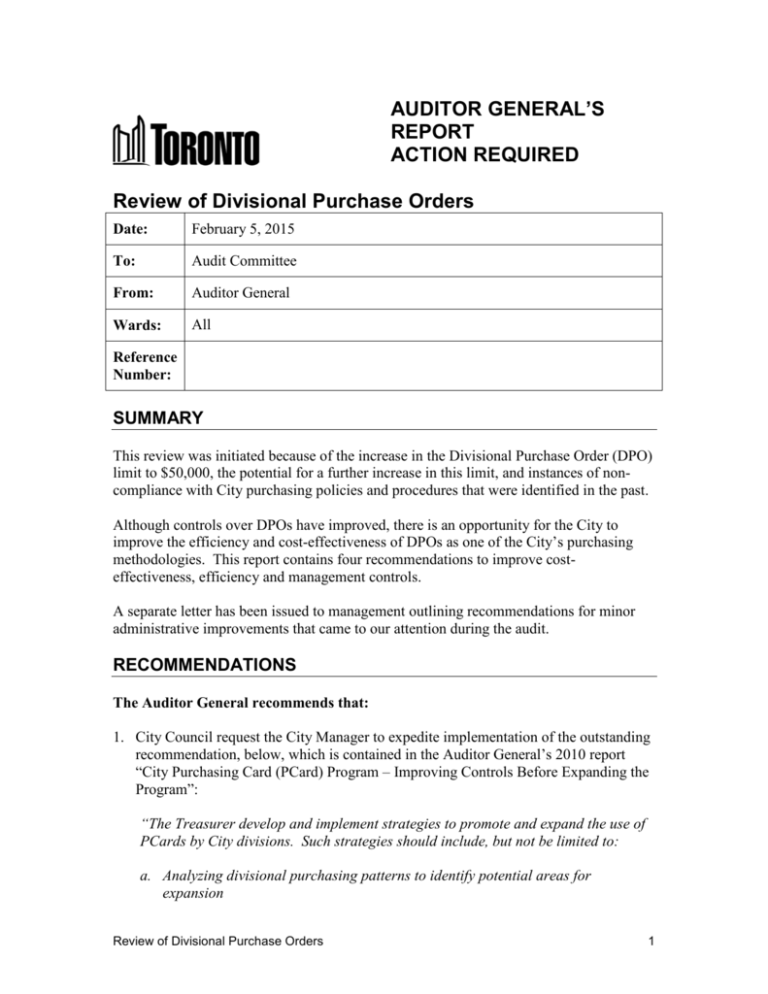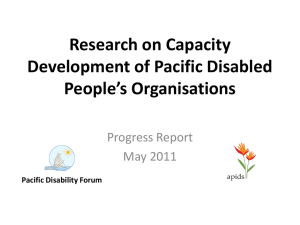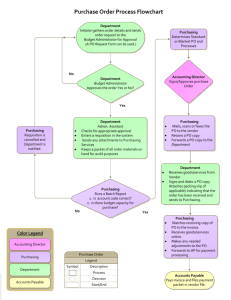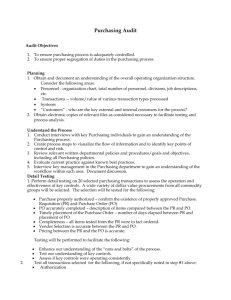Review of Divisional Purchase Orders
advertisement

AUDITOR GENERAL’S REPORT ACTION REQUIRED Review of Divisional Purchase Orders Date: February 5, 2015 To: Audit Committee From: Auditor General Wards: All Reference Number: SUMMARY This review was initiated because of the increase in the Divisional Purchase Order (DPO) limit to $50,000, the potential for a further increase in this limit, and instances of noncompliance with City purchasing policies and procedures that were identified in the past. Although controls over DPOs have improved, there is an opportunity for the City to improve the efficiency and cost-effectiveness of DPOs as one of the City’s purchasing methodologies. This report contains four recommendations to improve costeffectiveness, efficiency and management controls. A separate letter has been issued to management outlining recommendations for minor administrative improvements that came to our attention during the audit. RECOMMENDATIONS The Auditor General recommends that: 1. City Council request the City Manager to expedite implementation of the outstanding recommendation, below, which is contained in the Auditor General’s 2010 report “City Purchasing Card (PCard) Program – Improving Controls Before Expanding the Program”: “The Treasurer develop and implement strategies to promote and expand the use of PCards by City divisions. Such strategies should include, but not be limited to: a. Analyzing divisional purchasing patterns to identify potential areas for expansion Review of Divisional Purchase Orders 1 b. Developing and implementing measures to increase the use of PCards by divisions c. Setting performance goals for the City based on the number of participating divisions and yearly PCard purchase volume.” 2. City Council request the Director, Purchasing and Materials Management review and revise quality assurance procedures including: a. Taking a risk-based approach to selecting Departmental Purchase Order files for review b. Adjusting sample sizes to a manageable level, to allow for a balance between the sufficiency and timeliness of file reviews c. Tracking and monitoring the progress and compliance of divisions. 3. City Council request the Director, Purchasing and Materials Management expand the analysis of quarterly Divisional Purchase Order activity to include the identification of: a. Instances of invoice splitting b. Purchases being completed prior to creation of Divisional Purchase Order c. Excessive, repetitive purchases from the same vendor, regardless of value d. Opportunities for efficiencies through use of City’s purchasing cards or blanket contracts. 4. City Council request the Director, Purchasing and Materials Management to require staff be re-trained on the use of Divisional Purchase Orders in instances where consistently significant non-compliance is detected through quality assurance procedures. Financial Impact The implementation of recommendations in this report will improve financial controls over divisional purchase orders. The extent of any resources required or potential cost savings resulting from implementing the recommendations in this report is not determinable at this time. COMMENTS The objective of this audit was to determine if controls over DPOs are adequate to ensure compliance with City policies and procedures and that purchasing procedures are cost effective. Review of Divisional Purchase Orders 2 Purchasing and Materials Management Division has made progress in relation to decreasing the number of DPOs issued and providing formal training to staff responsible for issuing DPOs. Addressing the recommendations in this report will enhance efficiency and improve compliance with established procurement policies and procedures. The audit report entitled “Review of Divisional Purchase Orders” is attached as Appendix 1. Management’s response to each of the recommendations contained in the report is attached as Appendix 2. CONTACT Jerry Shaubel, Director, Auditor General’s Office Tel: 416-392-8462, Fax: 416-392-3754, E-mail: JShaubel@toronto.ca SIGNATURE _______________________________ Beverly Romeo-Beehler, Auditor General 14 PMMD 02 ATTACHMENTS Appendix 1: Review of Divisional Purchase Orders, Purchasing and Materials Management Division Appendix 2: Management’s Response to the Auditor General’s Review of Divisional Purchase Orders, Purchasing and Materials Management Division Review of Divisional Purchase Orders 3 Appendix 1 AUDITOR GENERAL’S REPORT Review of Divisional Purchase Orders January 30, 2015 Beverly Romeo-Beehler, CPA, CMA, B.B.A., JD Auditor General TABLE OF CONTENTS EXECUTIVE SUMMARY ........................................................................................1 BACKGROUND ...........................................................................................................2 AUDIT OBJECTIVES, SCOPE AND METHODOLOGY ...........................5 AUDIT RESULTS ........................................................................................................6 A. Efficiencies Can Be Achieved by Using Purchasing Cards Instead of DPOs for Small Dollar Value Purchases ........................................................................6 B. Purchasing and Materials Management’s Divisional Purchase Order Quality Assurance Program Needs Improvement ..............................................9 CONCLUSION ............................................................................................................12 -i- EXECUTIVE SUMMARY This review was initiated because of the 2007 increase in the Divisional Purchase Order (DPO) limit to $50,000, the potential for a further increase in this limit, and instances of noncompliance with City purchasing policies and procedures that were identified in the past. Objective of this audit The objective of this audit was to determine if controls over DPOs are adequate to ensure compliance with City policies and procedures and that purchasing procedures are cost effective. Annual use of DPOs has decreased since 2010 Purchasing and Materials Management Division (PMMD) has been working with City divisions to identify opportunities to use blanket contracts and thereby reduce the number of DPOs processed each year. In 2010, over 30 thousand DPOs were processed by various divisions. By 2013, the volume had decreased to just over 15 thousand DPOs. High volume of small dollar value purchases However, a significant percentage of the DPOs processed are for small dollar value purchases. In 2010, the Auditor General’s review of the use of City Purchasing Cards (PCard) noted that efficiencies could be gained by using PCards, with sufficient controls in place, rather than DPOs. The report recommended that the use of PCards be expanded. PMMD does not evaluate DPO activity to identify opportunities for realizing further efficiencies through increased use of PCards. Use of PCards decreased between 2010 and 2013 but showed an increase in 2014. DPO Quality assurance procedures enhancements recommended PMMD performs quality assurance procedures to ensure divisions comply with City purchasing policies and procedures. These procedures can be improved by: -1- • • • • • • Setting criteria for selection of files to be reviewed Adjusting number of files reviewed Reviewing more recent DPO files Tracking and analyzing results to evaluate level of improvement Using data analysis to a greater extent Implementing mandatory staff re-training when warranted Conclusion Although controls over DPOs have improved, there is an opportunity for the City to improve the efficiency and costeffectiveness of Divisional Purchase Orders as one of the City’s purchasing methodologies. This report contains four recommendations to improve cost-effectiveness, efficiency and management controls. A separate letter has been issued to management outlining recommendations for minor administrative improvements that came to our attention during the audit. Separate letter issued to management for minor administrative improvements BACKGROUND Divisional Purchase Orders limit increased to $50,000 in 2007 Divisional Purchase Orders (DPO) allow divisions to conduct their own process for purchases below a certain threshold. In 2007, the City Manager authorized an increase in the DPO limit from $7,500 to $50,000 (exclusive of taxes). A further increase to the DPO limit to $100,000 is currently being evaluated. It is important to provide staff with purchasing tools that allow them to efficiently and effectively undertake their responsibilities. Since this generally involves the delegation of certain authority, it is equally important to ensure that these tools are accompanied by adequate controls to ensure the procedures are cost effective, fair and transparent. -2- Auditor General noted several instances of noncompliance with purchasing policies in the past Several DPO issues identified in the past In the past, the Auditor General’s Office identified issues of noncompliant use of DPOs in several audit reports, including: • Departmental Purchase Orders – Enforcement and Compliance Measures (2001) http://www.toronto.ca/legdocs/2001/agendas/committees/ au/au011129/it004.pdf • Toronto Water Division – Review of Wastewater Treatment Program – Phase Two (2007) http://app.toronto.ca/tmmis/viewAgendaItemHistory.do?i tem=2007.AU5.3 • Process for Non-Competitive Procurement (Sole Sourcing) Needs Improvement (2009) http://app.toronto.ca/tmmis/viewAgendaItemHistory.do?it em=2009.AU11.5 • City Accounts Payable - Payment Controls and Monitoring Require Improvement (2013) http://app.toronto.ca/tmmis/viewAgendaItemHistory.do?it em=2013.AU10.10 Some of the issues identified were: • • • • • Lack of appropriate authorization Splitting of invoices to circumvent requirement to obtain quotes Use of DPOs when PMMD issued blanket contract or purchase order would be more appropriate and cost effective Inappropriate sole sourcing Purchase completed prior to processing of DPO We note that most of our recommendations related to these observations have been implemented. PMMD conducts quarterly and annual reviews of DPO activity Controls are designed to help ensure compliance with purchasing processes and identify areas where processes can be more efficient. For example, Purchasing and Materials Management Division (PMMD) monitors DPO use to detect certain types of non compliance with purchasing policies, specifically repetitive purchases from the same vendor where cumulative total exceeds $50,000, a condition that should be reviewed to ensure there was no abuse of the DPO process. -3- Based on a recommendation from the Internal Audit Division PMMD also perform a quarterly analysis of DPO activity that is distributed to PMMD Managers and Division Heads to identify opportunities: • • • • to eliminate repetitive DPO usage to obtain goods and services at a better value through the establishment of a blanket contracts to consolidate the acquisition of commonly used commodities to negotiate preferential pricing through the competitive process PMMD also reviews DPO files as part of their quality assurance procedures In addition PMMD performs a quality assurance process, developed by the Internal Audit Unit of the City Manager’s Office. Under this process, DPO files are randomly selected and reviewed for compliance with purchasing policies and procedures. Divisions are provided with the findings and are offered the option of requesting additional training for their staff. Declining trend in number of DPOs issued Figure 1 below demonstrates a trend to decreased use of DPOs. Divisional Purchase Order Annual Activity Source: City’s Financial Information System Approximately 4,000 unique vendors were awarded DPOs in 2013. While many vendors were issued only a few DPOs, several vendors were issued many DPOs and one vendor was issued over 700 DPOs. -4- AUDIT OBJECTIVES, SCOPE AND METHODOLOGY Why we conducted this review This review was initiated because of the 2007 increase in the Divisional Purchase Order (DPO) limit to $50,000, the potential for a further increase in this limit, and instances of noncompliance with City purchasing policies and procedures identified in the past. Audit objectives The objective of this audit was to determine if controls over the DPO process are adequate to ensure: • • compliance with City policies and procedures ensuring a competitive, fair, open and transparent process purchases and purchasing procedures are cost effective Audit scope The review included a detailed examination of DPOs awarded between January 1, 2013 and July 31, 2014. The overall DPO activity trends between the years 2010 and 2013 were also analyzed. Audit methodology Our audit methodology included the following: • • • • • • Review of relevant Council and Committee reports Review of applicable bylaws and policies and procedures Analysis of DPO activity from 2010 to July 2014 Examination of PMMD’s quality assurance procedures and findings Examination of documents and records Interviews with staff from: o o o o Compliance with generally accepted government auditing standards Purchasing and Materials Management Division Accounting Services Social Development, Finance and Administration Policy, Planning, Finance and Administration We conducted this performance audit in accordance with generally accepted government auditing standards. Those standards require that we plan and perform the audit to obtain sufficient, appropriate evidence to provide a reasonable basis for our findings and conclusions based on our audit objectives. We believe that the evidence obtained provides a reasonable basis for our findings and conclusions based on our audit objectives. -5- AUDIT RESULTS A. Efficiencies Can Be Achieved by Using Purchasing Cards Instead of DPOs for Small Dollar Value Purchases The use of DPOs has been declining through conscious efforts of PMMD and City divisions to identify opportunities to use blanket contracts and encourage PCard use. However, additional efficiencies can be achieved by expanding the use of City Purchasing Cards (PCards) for small dollar value purchases. Table 2: Divisional Purchase Order with Net Price $3,000 or Lower Year Number of DPOs under $3,000 Percentage of All DPOs Total Net Price (000) 2013 2012 2011 2010 12,114 12683 16,136 28,344 83% 84% 85% 85% $12,260 $12968 $14,972 $27,011 Source: City’s Financial Information System Use of PCard more efficient for purchasing small dollar items Using PCards is more efficient and cost effective than using DPOs. Currently approximately 83 per cent of all DPOs are for purchases of goods and services less than $3,000 and many of these purchases could be done using PCards. Although there have been concerns regarding controls over PCards, the related control environment has been significantly enhanced and there is very little difference in the level of control between PCards and DPOs. In 2010, Auditor General recommended expansion of PCard program In 2010, City Council adopted the Auditor General’s report “City Purchasing Card (PCard) Program - Improving Controls Before Expanding the Program”. http://app.toronto.ca/tmmis/viewAgendaItemHistory.do?item=20 09.AU14.4 -6- The Auditor General recommended: “The Treasurer develop and implement strategies to promote and expand the use of PCards by City divisions. Such strategies should include, but not be limited to: a. Analyzing divisional purchasing patterns to identify potential areas for expansion b. Developing and implementing measures to increase the use of PCards by divisions c. Setting performance goals for the City based on the number of participating divisions and yearly PCard purchase volume.” This recommendation has not yet been implemented. Administrative costs of processing DPO $70 more than PCard per transaction The report also highlighted the efficiencies that could be gained by using of PCards rather than DPOs for small dollar value goods and services. It also noted that: “Published studies have shown that the average cost per purchasing card transaction was approximately $70 lower than the cost associated with other purchasing methods.” However, PMMD does not review DPO purchasing activity to evaluate whether the same purchases could be made in a more efficient manner using PCards. The value of goods purchased using PCards and the number of PCard transactions decreased between 2010 and 2013 with an increase in 2014, as indicated in Table 3 below: Use of PCard has been decreasing Table 3: PCard Activity Year 2014* 2013 2012 2011 2010 Number of Active Cards 1,520 1,312 1,403 1,446 1,255 Number of Transactions 44,166 40,211 39,089 41,023 41,448 $9,399 $7,289 $7,473 $7,646 $10,232 $223 $181 $191 $186 $247 Total Dollar Value (000) Average Transaction Value Sources: Semi-annual Treasurer's Report on Activities of the Accounting Services and Purchasing & Materials Management Divisions – December 31, 2012 & December 31, 2013 * and PCard Key Performance Metrics Dashboard http://app.toronto.ca/tmmis/viewAgendaItemHistory.do?item=2014.GM29.7 -7- Recommendation: 1. City Council request the City Manager to expedite implementation of the outstanding recommendation below, which is contained in the Auditor General’s 2010 report “City Purchasing Card (PCard) Program – Improving Controls Before Expanding the Program”: “The Treasurer develop and implement strategies to promote and expand the use of PCards by City divisions. Such strategies should include, but not be limited to: a. Analyzing divisional purchasing patterns to identify potential areas for expansion b. Developing and implementing measures to increase the use of PCards by divisions c. Setting performance goals for the City based on the number of participating divisions and yearly PCard purchase volume.” B. Purchasing and Materials Management’s Divisional Purchase Order Quality Assurance Program Needs Improvement PMMD conducts quality assurance file reviews, performs quarterly data analysis of DPO usage, and provides staff training in an effort to address and reduce instances of non-compliance with procedures. Refinement of these control activities are needed, especially in light of the potential increase of the DPO limit from $50,000 to $100,000. PMMD performs two types of quality assurance activities as part of its DPO oversight function: • • Reviewing of supporting documentation for a sampling of DPOs Reviewing a quarterly report on DPOs issued that is analyzed for significant activity with one vendor where a blanket contract might be a better purchasing tool These two activities and recommended enhancements are described in more detail below. -8- Quality Assurance Review of DPO Files Number of files reviewed may be excessive In accordance with the DPO quality assurance procedures, PMMD selects up to 30 high-value (greater than $10,000) DPO files per year for review from each division. For some divisions with a low number of DPOs this means that 100 per cent of their files are selected for reviewed. In 2013, PMMD completed 214 file reviews, primarily from 2012 and prior years. This represents approximately 20 per cent of DPOs that were eligible for selection before 2012. As the findings from all these file reviews did not vary significantly, no additional value was gained by reviewing so many. File selection not based on risk criteria The only criteria used to guide the selection of files is that the DPO value must be over $10,000. Risks such as a division’s past level of compliance, repetitive purchases from same vendor or invoices dated prior to DPO creation date are not considered. More timely reviews are needed As a result of the high number of files being targeted for review, PMMD has been unable to complete their reviews on a timely basis. The information from PMMD’s current reviews, the files from 2011 and 2012, may be outdated because divisional staff compliance levels may have changed since the DPO was signed. Quality assurance procedures should include analysis of trends Results of these reviews are recorded in a database, however no analysis is conducted to identify trends within each division and from year to year. The quality assurance reviews should: • • • assess current rather than past performance issues develop action plans to address issues evaluate and track performance over time Quarterly Data Analysis Quarterly DPO data analysis is limited PMMD generates quarterly DPO activity reports to identify opportunities for the creation of blanket contracts. The staff identify vendors awarded DPOs with annual or quarterly cumulative value exceeding $50,000 to consider if the circumstances are appropriate to utilize blanket contracts, rather than individual DPOs. -9- Data analysis can provide valuable information While this is a good thing to monitor for, the quarterly report should be further analyzed to identify other issues that should form part of the monitoring process. For example, we examined data from 2013 and found: • • • • evidence of split invoices one vendor with over 700 DPOs DPOs created after invoices were received a significant number of low dollar value purchases This type of data should be followed-up to verify that divisions are complying with purchasing policies. Divisional training should be a requirement in some instances Finally once these reviews have been completed, instances of non-compliance are communicated to the relevant division head for their information and corrective action. Each of these communications contains a statement advising the division head that additional training may be requested. In some instances, where significant non-compliance has been noted, re-training should be mandatory. Recommendations: 2. City Council request the Director, Purchasing and Materials Management review and revise quality assurance procedures including: a. taking a risk-based approach to selecting Departmental Purchase Order files for review b. adjusting sample sizes to a manageable level, to allow for a balance between the sufficiency and timeliness of file reviews d. tracking and monitoring the progress and compliance of divisions. -10- 3. City Council request the Director, Purchasing and Materials Management expand the analysis of quarterly Divisional Purchase Order activity to include the identification of: a. Instances of invoice splitting b. Purchases being completed prior to creation of Divisional Purchase Order c. Excessive, repetitive purchases from the same vendor, regardless of value d. Opportunities for efficiencies through use of City’s purchasing cards or blanket contracts. 4. City Council request the Director, Purchasing and Materials Management to require staff be re-trained on the use of Divisional Purchase Orders in instances where consistently significant non-compliance is detected through quality assurance procedures. CONCLUSION This report presents the results of our review of Divisional Purchase Orders. PMMD has made progress in relation to decreasing the number of DPOs issued and providing formal training to staff responsible for issuing DPOs. Addressing the recommendations in this report will enhance efficiency and improve compliance with established procurement policies and procedures. -11- APPENDIX 2 Management’s Response to the Auditor General’s Review of Divisional Purchase Orders Rec No. 1. Recommendations Agree (X) City Council request the City Manager to expedite implementation of the outstanding recommendation below, which is contained in the Auditor General’s 2010 report “City Purchasing Card (PCard) Program – Improving Controls Before Expanding the Program”: X “The Treasurer develop and implement strategies to promote and expand the use of PCards by City divisions. Such strategies should include, but not be limited to: a. Analyzing divisional purchasing patterns to identify potential areas for expansion b. Developing and implementing measures to increase the use of PCards by divisions c. Setting performance goals for the City based on the number of participating divisions and yearly PCard purchase volume.” Disagree (X) Management Comments: (Comments are required only for recommendations where there is disagreement.) Action Plan/Time Frame The Treasurer and Accounting Services will roll out the full PCard strategy by the end of Q2 2015. The strategy will address the AGO recommendations that include the promotion and expansion of the PCard Program. The PCard Strategy will consist of a seven-pillar approach: 1. 2. 3. 4. 5. 6. 7. Active Program Management Optimize Purchasing Card Deployment Extend Purchasing Card Usage within the Procure-to-Pay Environment Corporate Virtual Card Leveraging Technology Achieving compliance & control while cutting costs and risks Performance Reporting (KPIs/Metrics) Completion by: Q2 2015 Page 1 Rec No. 2. Recommendations City Council request the Director, Purchasing and Materials Management review and revise quality assurance procedures including: a. taking a risk-based approach to selecting Departmental Purchase Order files for review Agree (X) X Disagree (X) Management Comments: (Comments are required only for recommendations where there is disagreement.) Action Plan/Time Frame PMMD will review and revise the Procedure for Divisional Purchase Orders (DPOs) Quality Assurance Reviews in consultation with the Internal Audit Division to determine the appropriate sample size based on a risk-based approach and the development of reports for Divisions to track and monitor progress and compliance. Completion by: Q3 2015 b. adjusting sample sizes to a manageable level, to allow for a balance between the sufficiency and timeliness of file reviews c. tracking and monitoring the progress and compliance of divisions. Page 2 Rec No. 3. Recommendations City Council request the Director, Purchasing and Materials Management expand the analysis of quarterly Divisional Purchase Order activity to include the identification of: Agree (X) X a. Instances of invoice splitting b. Purchases being completed prior to creation of Divisional Purchase Order Disagree (X) Management Comments: (Comments are required only for recommendations where there is disagreement.) Action Plan/Time Frame PMMD will expand the analysis of the Quarterly Divisional Purchase Order Report to include activities such as invoice splitting, purchases being completed prior to creation of the DPO and excessive, repetitive purchases from the same vendor and will consult with Accounting Services on identifying opportunities for efficiencies through Pcards or blanket contracts. Completion by: Q2 2015 c. Excessive, repetitive purchases from the same vendor, regardless of value d. Opportunities for efficiencies through use of City's purchasing cards or blanket contracts. 4. City Council request the Director, Purchasing and Materials Management to require staff be re-trained on the use of Divisional Purchase Orders in instances where consistently significant non-compliance is detected through quality assurance procedures. X PMMD, during the revisions of the DPO procedures as outlined in recommendation 2, will define criteria for the detection of consistently significant non-compliance that will require staff to be re-trained on the Procedure and use of DPOs. Completion by: Q3 2015 Page 3








